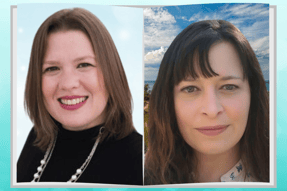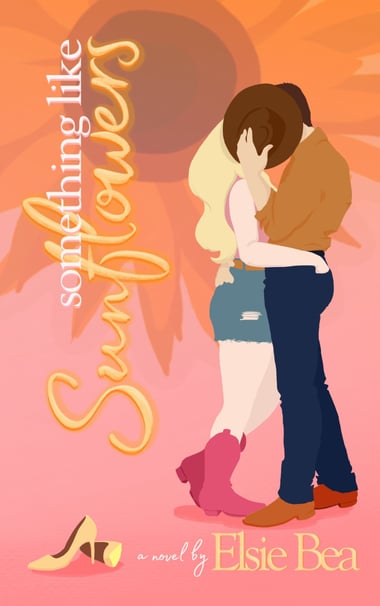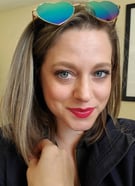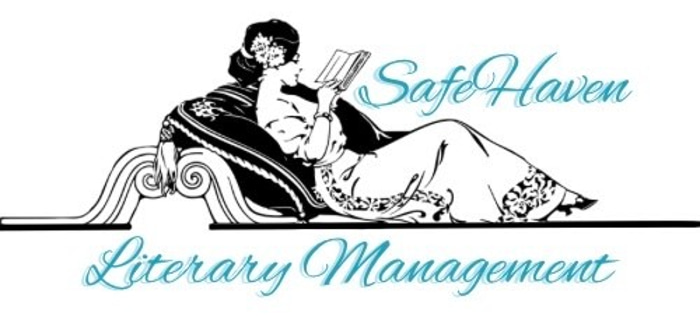Author Interview
Elsie Bea
BETWEEN THE COVERS
Deb
4/8/202516 min read


In our weekly feature, we will take you behind the scenes with some of the talented authors who have been interviewed on Beyond the Pages by Deb McIlroy & Erin Shea on our YouTube channel. Get a glimpse into their creative process, inspiration, and the stories behind their stories. Stay tuned for exclusive insights and anecdotes from the minds behind some of your favorite books.


What was your motivation for writing your latest book? Can you elaborate on the process behind it?
Something Like Sunflowers came to me in a time I needed to believe in healing and growth in my own life. My mom passed away right before I started the drafting process, and it was a hard season of life for me. I was really tormented with confronting my own mortality; unfinished business, hopes and dreams I had never chased…and I just knew I had to write this second chance, redemption type of story to channel my own growth. Bits and pieces of the initial inspiration for Devyn came when I watched my daughter talking to one of our roosters on the roof of the playhouse. I thought, when a head strong little farm girl grows up, what does she become? How does the world view her bossy, self-assured, confidence? We throw the B word around a lot when describing strong women, and I was fascinated with exploring the backstory behind that kind of person. I had read some books with unlikeable FMCS, It Happened One Summer by Tessa Bailey, and of course, ACOTAR’s Nesta, my favorite Sarah J. Maas character, and I knew I wanted to do that, too. I wanted to bring an unlikable character on a journey that gets us rooting for her growth and happily ever after by the end. With my background in theater, I could relate a lot to Devyn’s body image struggles and her onstage persona with pageants versus the person she feels like she’s hiding on the inside. All of those elements became my general framework for the story, and it just took off from there. I decided what sort of tropes I could play on within those parameters, and knew that with second chances, the brother’s best friend trope was going to fit so perfectly. It wasn’t until I was fully invested in the story that some of the external plot elements came into place, and even some of the most important side characters were introduced, but once I got going, it just felt like it wrote itself. The characters knew who they were and so did I, so we just spent a ton of time together until it was done.
This week, we have the pleasure of chatting with Elsie Bea, the talented author of Something like Sunflowers.


Look, I know I haven't been the greatest me I can be as of late. I'm selfish, materialistic, and I've forgotten where I come from, according to Hunter.
But that doesn't mean I'm not the same girl I was. Or could be.
Now more than ever, I need to convince everyone that I definitely could be. And by everyone, I mean the executive panel at Classy Country, the last three people standing in between me and my dream job.
The Issue? They don't think I fit in with their small-town values. Are you kidding me? I practically bleed small-town vibes.
Or I did.
I guess I've come a long way from pageants and pickup trucks. But I'm still the same girl who was born and raised in the sticks, and even though Hunter Isaac might know just how to get under my skin, that doesn't mean I can't bite back a little.
I know he's my brother's best friend. I know I've never hated anyone more. Most importantly, I know I shouldn't let myself fall for him again.
The only problem is...I married him last night.
Something Like Sunflowers is a small-town, brother's best friend, second chance romance with secret twists, a dirty-talking cowboy, and a happily ever after. Available Now in Paperback, E-Book or Kindle Unlimited.
Could you describe your writing routine and how you maintain focus and creativity throughout the process?
My routine is probably best described as chaotic. While I thrive on schedule, as a mom of two with a yard full of animals, there never seems to be much of a schedule. What I have found works, is to carve out at least three hours of time to review what I wrote the day before, try to get at least 2,000 words written, and summarize the chapter I want to work on the next day. Some days writing doesn’t happen, but when it does, I always try to be as focused as possible. The best writing happens for me when I zone completely into the story and imagine it playing in my mind like a movie. In theater, we’d call that being off book. That feeling when you know the characters and the lines, and you just live in the emotions and the actions of the scene. That’s when my best writing happens, when I let my mind wander and my fingers type what they imagine. After my first draft is written, I’ll go back through a couple passes with alpha and beta readers and make things more concise before official edits. As for creativity, it can be tough. But when I start to lose the spark, I switch to another project. The beauty of self-publishing is that no creative time is wasted time. I can always switch to marketing, newsletter creation, or even just make a mood board on Canva to share with my followers if I’m stuck. Often, that switch up is just what I needed to revive the spark or generate some new idea that pushes me to the next chapter.
Which themes resonate strongly in your writing, and what draws you to these particular themes?
Redemption and second chances are very present in all three of the books slated for the Something series. I think I consistently come back to these themes because they resonate with me. Our pasts are what shape us, and the people in our lives come in and out of them in ways we often don’t understand the impact of until years later. I love showcasing change and growth of the human mind. Another theme I keep finding in my writing, which surprises even me, is this idea of the flawed Christian character. We have Christian romance, we have sweet/clean romance, and then we have contemporary romance or spicy romance, which is technically what I write. But it’s not often that I find books showcasing the type of person that feels like me. Someone spiritual, who talks to God, who sometimes hates the God she says she loves, and I think most of us in our lives have felt too flawed to be a good model of their faith. Too flawed to fit in perfectly. Devyn has a moment in Something Like Sunflowers where she’s slightly tipsy and doesn’t want to see Hunter, so she prays to God to distract him, and it’s that irony, of being in the act of sinning and still finding yourself worthy of prayer that evokes a fascination in me. In Something Like Sugar, Book Two, which is in developmental editing stage now, Dustin feels that his past makes him unworthy of love, and he says, “God Plays puzzling games with my integrity,” when he’s faced with his own moral compass. And Lemon, my all-time favorite character, talks about going to church in Book 3, Something Like Starlight, and her MC gives her a bit of judgement for that, asking her how she can’t see the irony in someone like her being wild by night and attending church by day. She responds that every time she’s felt alone, there’s been something there in the darkness. She says, “It comes from somewhere, so I may as well search for it everywhere.” She also has a poignant flashback scene where a childhood trauma has her on her knees and she tells us she prays to a God she wishes she didn’t hate. I find this struggle with spirituality a raw and unexplored part of the human essence that I can’t help but throw into my characters that live in these very contemporary settings.
What message or impression do you hope to convey to your readers through your work?
I hope they take away a message that it’s never too late to believe in yourself. Our pasts don’t define us. We are all worthy of happiness.
What is your approach to crafting character arcs, and how do you ensure that they are relatable to readers?
At first, I don’t usually know what the arc is going to be, but I let the characters take the page and whine about what they want in the beginning of my draft. Once I realize what they really desire out of life, and what’s stopping them from getting it, the arc develops through actions. I think I approach this with a very theatrical eye because that was my first profession. In the theater we use actionable tactics to overcome obstacles and get what we want on stage. It happens beat by beat and scene by scene. You pull a piece of dialogue apart and decide how these characters could use their bodies and words to gain access to the overall goals of the scene. For example, Hunter doesn’t want Devyn to leave after the interview scene in the beginning of Something Like Sunflowers, and while he says a bunch of stuff to distract her and keep her there talking, he also holds his elbow down on the elevator door button to keep it shut. That’s an actionable tactic that an actor might use, that isn’t written in a script’s dialogue. So ,when I write, I always have those inherent story beats in mind, and my characters arcs develop through that process. Whatever they want the most, they need to believe they aren’t worthy of that from the get-go. And their arc needs to show the walls coming down so we can see them starting to believe that they are worthy of that goal, and they can achieve it. In our case, that’s a happily ever after with romance. Once I know what they want, I’ll do whatever I can in my writing to make it that much harder for them to get it. And if I can show how they have struggled with their fear of unworthiness in the beginning of the story enough, it makes it that much more satisfying when they change by the end. In Something Like Sugar, Dustin has a stutter that comes out a few times when he scuffles with his father, and by the end, he is able to talk to his father clearly. This tiny detail served to enhance his overall character arc that he is not worthy of love due to his past, because it can be drawn back to the same lack of confidence and doubt around being worthy of his father’s approval with his speech problems. Making small connections like that can help make the overall arc more colorful.
How do you tackle the challenge of pacing in your narratives? What techniques do you use to keep readers engaged?
My editor tells me I have a knack for upping the stakes and giving readers a page-turning end to a chapter, and I think that’s because I have so much fun with that part of it. Usually, I’m not even sure what’s going to happen from chapter to chapter, until I’m writing it out, so the surprises and twists are surprising and twisty, simply because I don’t see them coming either! It doesn’t always happen that way. Sometimes I have a saggy, long chapter, or one that doesn’t serve much purpose, but as a discovery writer or a pantser, I’ve learned that part of my process is writing my way into these new scenarios, and if I get stuck or feel like something is off, my alpha and beta readers will tell me it feels off, and that’s when I go back to tweak the sections they had issues getting through. When all else fails, my editor is amazing at pointing out where the pacing needs changed or when chapters need deleted all together. The best advice I have for keeping readers engaged is to keep making it harder for your main characters to achieve their goals—and not just achieve them but achieve them and be in love by the end of it. If I can make one character’s goal harder to reach because the other character’s goal is in direct opposition to theirs, it’s even easier to keep the reader turning the page. In Something Like Sunflowers, we see Devyn move home on a contingency of winning a job over her ex, but when she gets home not only is the pageant program that she was going to use to win the job no longer active, but she also gets drunk and marries the very man she is supposed to be competing against. What’s worse is she might even be falling back in love with him. None of that is helpful for her in winning the job at all, but now the reader wants to keep going to find out how on earth we will work our character out of this plot mess. Honestly, the plot mess sometimes trips me up, too, and even as I’m finishing up drafting Book 3, right now I find times where I write myself into a corner by raising the stakes too high. Unfortunately, I’m the only one who can write my way back out of that, so it can certainly be a challenge not being a plotter in this regard, but it does help immensely with suspense, pacing, and creating an unpredictable plot.
In what ways do you incorporate feedback from your peers or readers into your writing?
I incorporate it all! I love feedback. Again, theater nerd here, if I can make something better, I am obsessed with trying it. Sometimes that can thwart the process, because too much input can get conflicting, but I have found a handful of trusted alpha and beta readers who are voraciously reading the romance genre and posting detailed reviews, and those people are priceless to my creative process. I’ll have an alpha reader look over my initial draft as I’m writing it, sometimes even helping me figure out which parts are the most exciting and where they hope the story is going. Their initial reaction is super helpful in solidifying the marketable tropes, length, and pacing of chapters. Once I have the first draft written, I’ll send it to a couple beta readers for general input and make a few more changes before it goes to my editor for professional love. Alpha and beta readers are amazing for pointing out things you miss when you’re in pantser mode, like whether the tone matches the rest of the books in the series, or if a character from one of the other books doesn’t feel consistent from story to story. I’ve also had them give me insight on triggers, trigger warnings, potentially offensive or sensitive content, and language barriers within text. You honestly never know what people do for a living outside of Bookstagram, either, and it can feel like winning the lottery when you’re writing about a medical emergency, for example, and one of your beta readers worked in an intensive care unit. That kind of feedback is invaluable.
What has been the most surprising or rewarding part of your writing journey so far?
Finally putting my creative footprint out into the world is the most rewarding aspect of my journey so far. Years from now, when I’m gone, Something Like Sunflowers will still exist without me, on bookshelves or in libraries…maybe my great-great-greats will get dollars and cents royalties off my random bit of art for generations to come. Or maybe it will sit unread, but no matter what happens, it won’t be unwritten. I did the thing my heart screamed needed to be done while my brain told me I might never have what it takes to do it. It’s pretty cool to prove yourself right and wrong at the same time.
How do you make your settings come alive in your stories? Are there particular methods you use?
Pine Forest is a fictional small-town in the world of Something Like Sunflowers, but I modeled it closely after my hometown in Virginia, so I could have a beach close by and a big city (New York) only a few hours away. Because I have Virginia in mind as the setting, it makes it easier for me to put myself into the world of the story by using weather and seasons closely aligned with my own. In Sunflowers, it’s fall when Devyn moves back home, and I mention the pinkening leaves, or the crisp wind of October in Something Like Sugar, Book 2. I use weather often to bring my setting to life because it also gives my characters a chance to become more dimensional. They can feel, smell, or taste parts of their environment such as salty ocean air, manure in the cow fields, or the stars under the country sky on a summer night. Another way I make them come alive is by using similar landmarks, like the Sugar Stable, an ice cream parlor that Shana’s brother Dustin runs, and it shows up in all three books so far as a meeting place for the friend group. I see this story device used in a lot of successful small-town romance series, because using restaurants or central locations, the audience can connect the whole series of standalones as one world. Like, “Hey! We went to that same bar in the last book.” It’s an immediate connection to that place for the reader without even trying. Similarly, I’ll bring back characters from book to book, like the old man at the feed store who always seems to meddle into the affairs of others. Readers then come to expect that they might run into those same side-characters from book to book, and I hope they have fun in these next two Something installments with the Easter eggs and nods to Sunflowers I’ve been creating. This aspect of world-building has certainly been a blast for me.
What are the common misconceptions people have about being a writer that you would like to address?
I think people confuse traditional publishing with self-publishing. We do not have a publisher paying for upfront costs, and we certainly don’t have the ability to focus solely on writing and editing. Most of us are doing our own marketing and web design, especially if we are new. It costs a lot of money to hire editors, cover designers, formatters, and proof-readers, so it’s an expensive career. Nobody is giving indie authors advances, and bookstores require such high wholesale discount pricing that we often get paid dollars and cents in royalty fees to be on physical shelves. We do it because we love it, and we believe in our work, at least I do. But it’s not making everyone rich. A lot of people also assume if you write something, you had to have experienced it at some point, and I’m here to dispel that. While I might grab and take pieces of my experiences and put them into my characters, I am writing fiction for a reason. I want the freedom to create something that isn’t real, even if it is realistic. And yes, that goes for the spicy bits, too.
Could you share an experience where you faced significant criticism, and how did it affect your work?
Most of the time, any feedback feels like it’s crucial at first, but I’m thankful to my years on the stage having broken down that part of me that fears criticism. I embrace it now. When it feels negative or personal, I usually try to re-read it, listen to it again, and dissect it for what it is at a fact-based level. It’s someone’s opinion, and it could be right or wrong based on what I’m trying to convey as a writer and storyteller, but it can only help me to analyze it. Sometimes it can feel rough, like someone is stabbing you with things they wish you’d have done differently, but I try to only take the criticism when I can do something about it. Are we still drafting or editing? Let’s go through this story and change things up then. Let’s make it even better. If it’s too late for that, like a two- or three-star review on an already published book, then it is what it is. I have had a few people rate Sunflowers as a three, and the first reaction was, “How could they? It’s at least a 4!” But my three and your four could be the same number. And the reality of it is, not everyone loves every book, but if I can reach those readers who say stuff like, “You got me back into reading,” or “I couldn’t put this down!” then I’m also finding the right people for this story, even if I am reaching a few of the people who it isn’t vibing with. Just like not every actor isn’t funny to every audience, every story isn’t written for every person. You have to let it roll off, know who you are in your heart, and keep searching for your true readers.
What role does a supportive writing community play in your life as an author? How has it influenced you?
I love this question. When I was starting my Sunflowers draft, I had been an avid reader of romance for quite a few years, so I reached out by direct message to my favorite romance author with questions on marketing, and she actually replied! Not only did this woman with ten years of publishing experience and over forty-thousand followers on social media reply to me, but she sent actual voice notes of her advice. I was blown away by her support. Here she was, one of my favorite published authors-and she’s her, and I’m just me- and she was offering me advice on how to break into her industry. I’ll never forget how much of a cheerleader she was at that moment, and it definitely made me feel welcomed in the world of publishing. I still feel like I’m just me, but one day when I’m like her, I’ll be sure to help someone new. That much I do know.
What advice would you give aspiring authors when it comes to getting published? Any tips on navigating the publishing landscape?
I can only speak to the self-publishing process, but I would say the best advice is just finish the book. Once you have a draft, you can mold it into anything you want it to be. And don’t be afraid to reach out to your peers on social media who are also writing or publishing, because they are your confidence when you lack it. They have done it, and you can too. YouTube is a great place to start for anyone wanting to self-publish or learn more about writing craft. Kia Carrington-Russell, Alexa Donne, The SPA Girls, and Mandi Lynn are all authors with YouTube channels on every aspect of the business, from drafting to ads and marketing, and are incredible resources for absolutely free. A paid resource that I couldn’t dream of being without is Romancing the Beat by Gwen Hayes. I find her approach to story structure very similar to theater analysis, and if you’re like me and want to see solid examples of each beat, she does just that. Believe in yourself, most importantly.
Buy Here


Website







